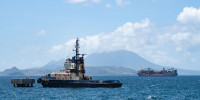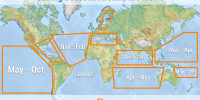Sailing Across the Atlantic Is Cheaper Than You Think
While sailing across the Atlantic may seem like an expensive and luxurious experience, it's actually more affordable than you might think. Yes, there are certain expenses involved, but careful planning and budgeting can help make this dream a reality.
To sail across the Atlantic, you can buy a new sailboat for $20,000–$200,000 or rent a boat for $300–$1,000 per day. For purchased boats, the maintenance costs range from $1,000 to $5,000, while the insurance costs run from $500 to $2,000 annually. Food and other provisions cost around $20–$50 per day per person.
Choosing the right vessel to sail across the Atlantic will not only affect your comfort during the journey but will also impact your budget. Let's see what other factors can affect the cost of sailing across this vast ocean.
Summary
- Your chosen route will affect your sailing duration. If you take longer while sailing across the Atlantic Ocean, you can expect to pay more for provisions, fuel, and the wages of crew members.
- You can consider buying a boat, either new or used. There are used sailboats that can cost less than $20,000, but you might need to spend more on maintenance and repairs to keep them seaworthy.
- When choosing the right vessel, consider your priorities. If you are willing to sacrifice comfort for a lower cost, you can go for smaller boats. If you're okay with spending more for a more comfortable journey, go for bigger ones.

On this page:
Breakdown of Expenses When Sailing Across The Atlantic
Sailing across the Atlantic can be more affordable than you think. Below, let's break down the possible expenses you may need to consider when sailing across this region.
| Possible Expenses | Estimated Cost Range |
|---|---|
| Boat purchase | $20,000 - $200,000+ (new) or less (used) |
| Boat rental | $300 - $1000 per day |
| Maintenance and repair | $1,000 - $5,000 per year |
| Provisions | $20 - $50 per day per person |
| Insurance coverage | $500 - $2,000 per year |
| Fuel consumption | $20,000 - $25,000 for a one-way trip (based on 5000 gallons of petrol and a fuel efficiency of 2.5 nautical miles per gallon) |
| Total Cost | $50,000 to $300,000+ (depending on various factors) |
The cost of buying or renting a boat
One of the biggest expenses when it comes to sailing across the Atlantic is the cost of the vessel. If you're planning to purchase a boat, the cost can vary greatly depending on the size and type of boat you choose. On average, a new sailboat can cost anywhere from $20,000 to $200,000 or more. However, you can also find used boats for much less.
If you don't want to purchase a boat, you can also rent one. The cost of renting a boat can vary greatly depending on the size and type of boat you choose. Rental fees can cost between $300 and $1,000 per day, depending on the size and type of boat. There are yachts that can be rented for as low as $10,000 per week.

The cost of maintenance and repair
Regular maintenance and repair can keep your vessel in good condition, which in return, ensures your safety during your journey. Maintenance costs can vary greatly depending on the size and type of boat you have, but on average, you can expect to spend around $1,000 to $5,000 per year on maintenance. Sailboats have an annual maintenance cost of around $2,000 - $3,000.
If you need to make repairs during your journey, the cost can vary greatly depending on the extent of the damage. Try to have an emergency fund set aside for unexpected repairs.
The cost of provisions and fuel consumption
Food and other services can cost around $20 to $50 per day per person.
If you use a large boat, the costs can go up considerably. However, using a small boat will compromise your safety, and you will be risking your life if you get stuck in rough waters or a storm.
Fuel costs will also depend on the size and type of boat you have. A typical powered boat would require a tank with a capacity of roughly 5,000 gallons of petrol and a fuel efficiency of 2.5 nautical miles per gallon to traverse the Atlantic. This is based on a gasoline consumption rate of 4 gallons per hour at a cruising speed of 10 knots.
To know the fuel consumption of different sailboat sizes, you can read this article.
The cost of insurance coverage
Insurance costs will depend on the size and type of boat you have, as well as the coverage you choose. On average, you can expect to spend around $500 to $2,000 per year on insurance.
Different types of sailboats have different insurance costs. See this article for more information: Average Sailboat Insurance Cost in 2023 (13 Examples)
Additional Costs To Consider and How You Can Save Money

There are always additional costs to consider beyond the initial expenses of purchasing or renting a boat when planning to sail across the Atlantic or even in any other region. Here are some ways to save money and make the journey more comfortable:
Consider the marina fees
Marina fees can be a significant expense, especially if you're traveling during the high season. To save money, try to consider anchoring out in a protected cove or bay instead of docking at a marina.
This will give you a chance to enjoy the natural surroundings and save money at the same time. To help you pick a safe anchorage, you can follow this guide.
Factor in the wages and expenses of the crew members
If you're planning on hiring crew members to help you sail across the Atlantic, perhaps factor in their wages and any associated costs, such as food and lodging. One way to save money is to find crew members who are willing to work for free in exchange for the experience of sailing across the Atlantic.
Take into account expenses for preparing your boat
Preparing your boat for an Atlantic crossing can be expensive, but it gives the assurance that your vessel is seaworthy and equipped with all the necessary safety gear. There are a few key pieces of gear and supplies that you'll need for your journey. These include:
- Navigation tools, such as charts, compass, and GPS
- Sails and rigging
- Safety gear, such as life jackets, harnesses, and a life raft
- Maintenance tools, such as spare parts, tools, and lubricants
To save money, perhaps consider purchasing used equipment or borrowing gear from friends who have already made the crossing.
You might also want to purchase a watermaker which can be essential for any long-term sailing journey. It allows you to produce fresh drinking water from seawater. A fridge is also a great addition, as it allows you to keep perishable items fresh for longer.
You could also try purchasing solar panels. Although the initial cost is expensive, it will allow you to save money in the long run. A solar panel is a great way to keep your batteries charged while you're out at sea. It can generate power without the need for a generator or engine, which can save you money on fuel costs.
Think about shipping and delivery instead of sailing
If you're on a tight budget, you can consider shipping your boat across the Atlantic instead of sailing it. This can be a cost-effective option, especially if you're not in a hurry. Another option is to hitch a ride on a freighter, which can be less expensive than sailing on your own boat.
If you're planning to sail from the Caribbean to Europe via the Atlantic Ocean, you might want to take advantage of delivery services instead. This can be a cost-effective option, especially if you're not interested in making the return trip.
Transporting a sailboat via land only costs from $1.50/mile to $3.50/mile, depending on the size of the boat and the direction you are traveling. Many other delivery services offer more competitive rates and can help you save money on fuel and other expenses.
Cost Factors to Consider To Stay Within The Budget

When planning to sail across the Atlantic, you need to consider several cost factors to ensure that you stay within your budget. Here are some of the factors that you should keep in mind:
Choose the right size and type of vessel
The size and type of boat you choose will significantly affect the cost of your journey. Here are a few things to keep in mind when choosing the right vessel:
Consider the size and comfort
The size of your vessel will directly affect your comfort during the journey. While a smaller boat may be more affordable, it may not provide the necessary space and amenities for a comfortable trip. Larger boats, such as catamarans or yachts, offer more living space and storage, but they come with a higher price tag.
Try to consider your priorities. Are you willing to sacrifice comfort for a lower cost, or are you willing to spend more for a more comfortable journey? Keep in mind that you will be spending several weeks on the boat, so you must choose a vessel that you are comfortable with.
Choose between a motorboat and a sailboat
While motorboats are faster and more reliable, they come with a higher cost. Sailboats, on the other hand, are slower but more affordable. They also offer a more authentic sailing experience, which may be important to some travelers.
When deciding which of the two is best, perhaps consider your budget and your sailing experience. If you are an experienced sailor and enjoy the challenge of sailing, a sailboat may be the right choice for you. If you prefer a faster and more reliable option, a motorboat may be a better fit.
Choose one with lower maintenance costs
If you're having a hard time choosing which boat type and size to go, take into account the maintenance and wear and tear of your vessel. Maintenance costs can add up quickly, especially for larger boats. You may want to consider the age and condition of the boat, as well as any necessary repairs or upgrades.
Plan out your route and your sailing duration
The route and duration of a sailing journey across the Atlantic Ocean can significantly affect the cost of the trip. This is because the longer the journey and the more complex the route, the more resources and supplies are required to ensure the safety and comfort of the crew.
If a sailor decides to take a direct route from New York to Lisbon, the journey could take around 12-14 days, depending on the weather conditions. During this time, the crew will need to be well-provisioned with food, water, and fuel, as well as have access to safety equipment and communication devices. The cost of these supplies will depend on the size of the vessel and the number of crew members on board.
On the other hand, if a sailor decides to take a more complex route, such as sailing from New York to the Caribbean, then to the Azores, and finally to Lisbon, the journey could take several weeks or even months. This would require much more planning and preparation, as well as additional supplies and provisions to keep the crew safe and comfortable during the longer journey.
In addition, the duration of the journey can also impact the cost of the trip. On average, you can sail across the Atlantic in 3 - 4 weeks, and you can make it in 2 weeks if you're lucky, but it won't always be the case.
A longer journey will require more fuel and supplies, which can add up quickly. The crew will also need to be well-rested and well-fed to maintain their physical and mental health during the journey, which can also increase the overall cost.
Did you find the answer to your specific question?
👍 0 👎 0




Leave a comment